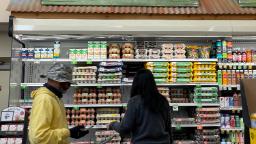
Washington, DC
CNN
—
Spending at US retailers fell in March as shoppers pulled again after the banking disaster fueled recession fears.
Retail gross sales, that are adjusted for seasonality however not for inflation, fell by 1% in March from the prior month, the Commerce Division reported on Friday. That was steeper than an anticipated 0.4% decline, in line with Refinitiv, and above the revised 0.2% decline within the prior month.
Traders chalk up a few of the weak point to a scarcity of tax returns and issues a couple of slowing labor market. The IRS issued $84 billion in tax refunds this March, about $25 billion lower than they issued in March of 2022, in line with BofA analysts.
That led shoppers to tug again in spending at department shops and on sturdy items, resembling home equipment and furnishings. Spending at normal merchandise shops fell 3% in March from the prior month and spending at gasoline stations declined 5.5% throughout the identical interval. Excluding gasoline station gross sales, retail spending retreated 0.6% in March from February.
Nevertheless, retail spending rose 2.9% year-over-year.
Smaller tax returns seemingly performed a job in final month’s decline in retail gross sales, together with the expiration of enhanced meals help advantages, economists say.
“March is a extremely necessary month for refunds. Some people may need been anticipating one thing much like final yr,” Aditya Bhave, senior US economist at BofA International Analysis, advised CNN.
Credit score and debit card spending per family tracked by Financial institution of America researchers moderated in March to its slowest tempo in additional than two years, which was seemingly the results of smaller returns and expired advantages, coupled with slowing wage progress.
Enhanced pandemic-era advantages supplied via the Supplemental Diet Help Program expired in February, which could have additionally held again spending in March, in line with a Financial institution of America Institute report.
Common hourly earnings grew 4.2% in March from a yr earlier, down from the prior month’s annualized 4.6% improve and the smallest annual rise since June 2021, in line with figures from the Bureau of Labor Statistics. The Employment Value Index, a extra complete measure of wages, has additionally proven that employee pay features have moderated this previous yr. ECI knowledge for the primary quarter of this yr will likely be launched later this month.
Nonetheless, the US labor market stays strong, though it has misplaced momentum just lately. That would maintain up client spending within the coming months, stated Michelle Meyer, North America chief economist at Mastercard Economics Institute.
“The large image continues to be favorable for the patron when you concentrate on their earnings progress, their stability sheet and the well being of the labor market,” Meyer stated.
Employers added 236,000 jobs in March, a sturdy achieve by historic requirements however smaller than the typical month-to-month tempo of job progress within the prior six months, in line with the Bureau of Labor Statistics. The newest month-to-month Job Openings and Labor Turnover Survey, or JOLTS report, confirmed that the variety of accessible jobs remained elevated in February — however was down greater than 17% from its peak of 12 million in March 2022, and revised knowledge confirmed that weekly claims for US unemployment advantages had been increased than beforehand reported.
The job market may cool additional within the coming months. Economists on the Federal Reserve count on the US financial system to move right into a recession later within the yr because the lagged results of upper rates of interest take a deeper maintain. Fed economists had forecast subdued progress, with dangers of a recession, previous to the collapses of Silicon Valley Financial institution and Signature Financial institution.
For shoppers, the consequences of final month’s turbulence within the banking trade have been restricted to date. Shopper sentiment tracked by the College of Michigan worsened barely in March in the course of the financial institution failures, but it surely had already proven indicators of deteriorating earlier than then.
The newest client sentiment studying, launched Friday morning, confirmed that sentiment held regular in April regardless of the banking disaster, however that increased gasoline costs helped push up year-ahead inflation expectations by a full share level, rising from 3.6% in March to 4.6% in April.
“On internet, shoppers didn’t understand materials modifications within the financial surroundings in April,” Joanne Hsu, director of the surveys of shoppers on the College of Michigan, stated in a information launch.
“Shoppers expect a downturn, they’re not feeling as dismal as they had been final summer time, however they’re ready for the opposite shoe to drop,” Hsu advised Bloomberg TV in an interview Friday morning.
This story has been up to date with context and extra particulars.



